Unless you live in a hermetically sealed box, you likely know that the serial be-heading of the speed camera on Parkside Drive has mutated from a weird slice-of-city-life story to the digital front page, from City Hall to Queen’s Park, and from High Park to the rest of Toronto, as the pranking has metastasized, because, well, why not? An inflection point is looming and I suspect it will take the form of some kind of pulling of the plug until…studies, reports, etc.
The fate of these cameras, needless to add, is so not the point, yet the epic absurdity of this story has served to eclipse the underlying problem, which is road safety. Parkside is a street/arterial that functions like a high-speed on-ramp to Lakeshore and the Gardiner, and has produced too many pedestrian and cyclist injuries and deaths in recent years — almost 1,500 collisions between 2014 and 2024, five serious injuries and two deaths.
The city is working through a viscous exercise in improving that stretch, with proposals (adopted “in principle” by council last fall) for lane reductions, full-time on-street parking on the east side, and a two-way cycle track, demarcated by lines or, where possible, physical barriers.
“Design work on these road safety changes is advancing,” a city spokesperson told me this week. “Once detailed design has advanced and further public engagement takes place, City staff will report to the Infrastructure and Environment Committee and City Council to seek authority for implementation. We currently don’t have a timeline for the report to IEC.”
With Doug Ford now fully engaged (enraged?), I’m guessing no one at 100 Queen Street West is in a hurry to come out with anything specific that will result in lane reductions.
I don’t want to focus on either the camera or the future of the road per se, but rather potential safety improvements the city has mainly dismissed — i.e., confronting the precarious condition of the west side of Parkside, a stretch that includes lengthy and narrow beaten paths that encourage pedestrians to take the risks that result in tragedies.
The above-mentioned staff report summarily dismissed the possibility of putting a proper sidewalk on the west side, citing, by way of reasoning, the presence of street light poles and the “impacts to environmentally sensitive and protected areas with established trees, shrubs, and other natural features. Additional topographic features such as grade changes and retaining walls pose additional engineering constraints.”
The rationale, according to the city spokesperson, is that several layers of provincial and city rules apply to the strip of High Park that abuts Parkside Drive, including the ravine by-law and the official plan’s protections for “environmentally significant areas” within the city’s natural heritage system, which includes a few large parks and the ravine network. As well, that sliver of the park is deemed to be part of an Area of Natural and Scientific Interest (ANSI) that covers High Park.
This is where the city has determined that it couldn’t possibly do anything to improve pedestrian access or safety on the west side of Parkside Drive, which may be the correct response from a narrow regulatory perspective, but falls well short of the type of practical problem solving you’d hope would prevail in a situation where public safety is compromised.
That particular strip of High Park is a bit of a dog’s breakfast. In some sections, there’s an old stone retaining wall. In others, where Parkside abuts the ravine slopes running into High Park, there are old guard-rails, but they’re positioned a few feet back from the curb, allowing enough space for a narrow beaten path that threads several hundred metres between the barriers and the roadway. Elsewhere, that same beaten-path veers up onto a grass sports field, and follows a course well back from Parkside.
In a few places, the city installed a couple of metres of sidewalk, which end abruptly at a stand of trees or, in one spot, in the middle of a patch of grass — a gesture that all but shouts at the city’s willingness to down tools when it comes to addressing Parkside’s safety hazards.
The invocation of the environmental restrictions in this stretch strikes me as a case of letting the perfect become the enemy of the good. High Park would not look and function as it does if it was planned according to present-day environmental rules, and so it feels intuitively wrong to insist that fixes intended to make it safe(r) should have to clear such a high bar.
For example: there’s a little stretch of road in the north-west corner (Wendingo Way) which loops through forest and basically provides street parking for the houses on the slope running down into the park. On Ellis Park Road, nearby, a proper (and newly paved) sidewalk plus a guardrail skirts the ravine side of that street, not the house side. Over at the south-east corner, an odd little parking lot, just off Parkside, is carved into the forest; it’s been there as long as I can remember. Several of the internal streets have sidewalks on one or both sides — sidewalks that presumably today would not pass muster with the aforementioned laws.
As for road safety, there’s a curve on Colbourne Lodge Drive that skirts a steep forested slope. But in this spot, the city has placed the guard-rails close enough to the roadway such that there’s no space for pedestrians to create a beaten path — which makes good sense from a safety perspective because that stretch has a blind curve and is still accessible to cars.
Point is, there are all sorts of practical things the city could do to sort out the riskiest parts of the west side of Parkside:
- Re-locating guardrails to the very edge of curbs so they don’t encourage people to walk on narrow beaten paths that are fully exposed to south-bound traffic;
- Investing some landscaping effort into making those parts of the beaten path that traverse the grassy areas into proper walkways, and then direct these away from the edge of the street with fences and signage;
- Completing the half-assed sidewalk that was built south of Algonquin;
- Adding guardrails that hug the curb on all those remaining stretches where there’s no protection and obvious evidence of pedestrian use.
None of this is complicated, nor does it involve re-programming Parkside, with all the political complexity that such changes entail.
I suspect, but couldn’t confirm, that part of the problem here involves bureaucratic silos: the city’s transportation services division is holding the Parkside hot potato, but some of these fixes necessarily involve the parks department, whose jurisdiction begins a few feet in from the curb. The staff report shows no evidence that the city’s transportation planners attempted to collaborate with their counterparts in the parks division to find common sense solutions to a safety concern that has garnered intense public, media and political attention. Why not?
Despite all the arm-waving, little on Parkside has actually improved since the 2021 crash that took the lives of an older couple. As Faraz Gholizadeh, co-chair of community advocacy group Safe Parkside, told the CBC following the sentencing this year of the man convicted in their deaths, reduced speed limits and the infamous cameras haven’t really led to safer driving.
Gholizadeh’s group has advocated for the complete re-design of Parkside, but there’s no reason the city can’t make more straightforward safety improvements while we’re waiting for the larger planning and road re-construction processes to play themselves out. After all, as the city itself admits, there have been numerous collisions, pedestrian and cyclist injuries, and two deaths on this stretch over the past decade. The next one could occur tomorrow.
So why wait? Surely a few guard rails won’t despoil the ragged eastern edge of High Park.
photo by Joey Schwartz

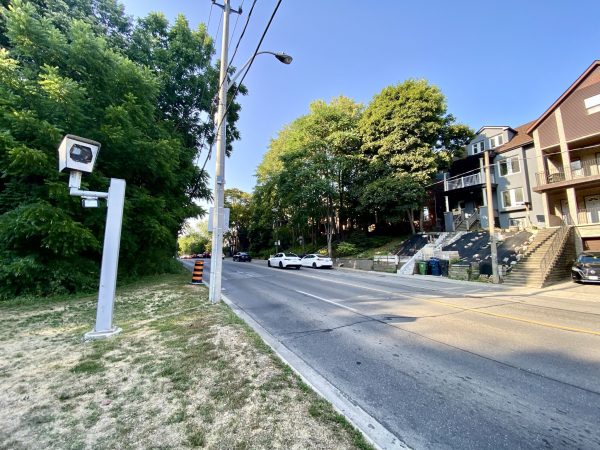

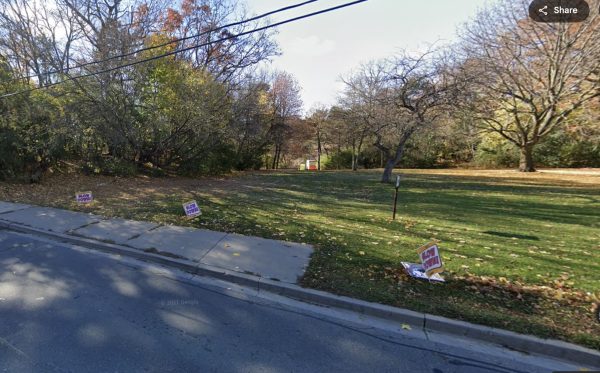
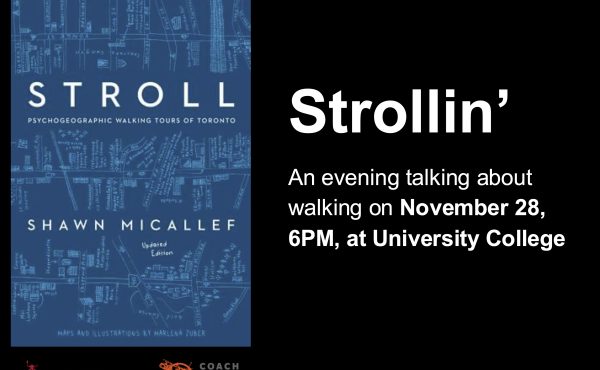
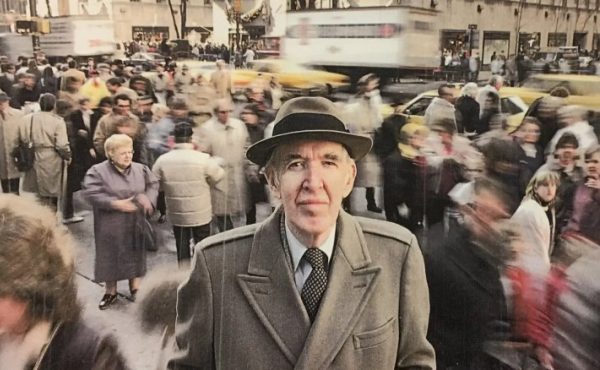
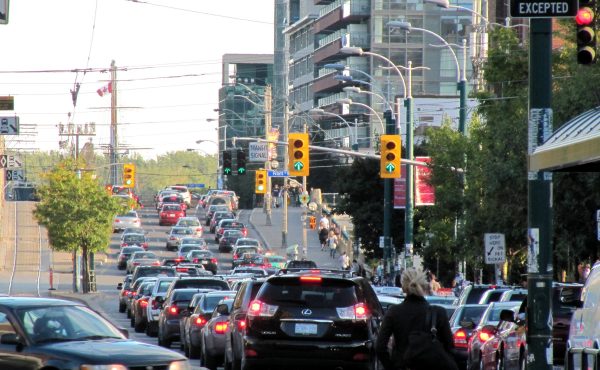
7 comments
Excellent points.
I’d like to add: The main rhetoric of the pro speed camera is that speed kills. I don’t believe speed kills; I do believe bad driving habits kill, bad bicycling practice kills, bad pedestrian behaviour kills. The three of these combined in a high density area, or on one of the only arteries to escape the city, is a recipe for bad stuff to happen.
I believe the speed cameras are a knee jerk reaction to a complicated problem. Where Nobody is talking about the complexity of the problem, and are praising these hidden speed cameras as the saviour to safety.
Moreover, the optics of these cameras are horrible. It makes it quite easy to believe the intent is revenue generation over safety. The reason being the nefarious nature of the cameras themselves, their hidden locations, the minimal signage and other dubious things associated with them, like removing speed bumps where a camera is placed for one example.
If the cameras were truly about getting cars to slow down, painting them florescent pink, having large signage (not a little sign that looks like the million other street parking signs around it), or even painted markings on the road like in many parts of Europe would arguable be effective in slowing traffic. The speed camera ought to be well shown, not hidden.
The speed cameras also pose an ethical dilemma and the direction of technology and governance. I personally am against speed cameras for ethical and moral reasons of how we handle our city/society.
Moreover, not enough studying is being done around speed cameras and their effectiveness of safety (not speed) or their lack thereof. Unfortunately, people are struck and killed on a daily basis in Toronto. Many of them I believe are at low speeds. I personally knew a friend that was struck and killed at approx 10km/h. No speed camera would have saved her.
Speed itself doesn’t kill; unsafe habits in stupid circumstances kill.
I agree there are other ways to ensure safety on Parkside. With regards to slowing down traffic.. the obvious solution is speed bumps. We don’t need a million of them, just a few in between lights so that no one can reasonably go above 30-40 km/h, unless they want to destroy their vehicle. Ellis has them for a reason coming down the slopes.
Finally some common sense on the issue. Cameras don’t make roads safer, they just create a mechanism for generating fines. This is why many people will argue the cameras are not about safety as much as they are about generating revenue. Or, as some might say: a cash grab.
There are 7 million reasons since 2022 why the cameras haven’t make Parkside safer. If Olivia Chow wanted to make the road safer, she could put a shovel in the ground tomorrow. But Chow prioritized the bike lanes that Ford won’t let her have on Parkside instead of making the road slower and safer – ideology over safety. In the meantime, the Parkside camera prints money for the city.
Speed bumps are generally not placed on streets with truck and bus (80 QUEENSWAY) traffic.
I do see that the “speed cameras are just a cash grab” bunch is out in force.
I drive everywhere in the city for work (no I am not an Uber driver) and drivers in Toronto are *terrible*. The speed cameras have made a huge difference. People not only don’t speed, they tend to drive at the same speed around cameras. This is much safer than some people doing more or less the speed limit while someone in a hurry tries to work through traffic at 10-30 km/h faster.
Considering that the cameras have tamed former free-for-all streets such as O’Connor east of Don Mills and Ellesmere east of Birchmount, they obviously are doing what they are supposed to do.
For the “oh it’s a cash grab” folks, you know the signs are pretty obvious. If you see a community safety zone sign (you *do* watch out for these, yes?) look if there’s an additional speed camera sign.
As I noted, I drive everywhere in the city, and I have never been ticketed by a speed camera. That’s despite going places I’m not familiar with. For some locals to get multiple tickets from one camera–well are they *that* clueless and careless? I guess so.
Speed cameras slow traffic to save lives!
Would you rather replace them with stop signs and speed bumps at every school?
We can’t afford traffic police everywhere all the time.
If you don’t speed they will save you money!
^^ I don’t think Jim read the article, just the headline. Or he doesn’t know the cost of buying/maintaining/installing a speed camera multiple times. This article is on your side — don’t make the perfect the enemy of the good, like the author says.
Speed cameras are a slush fund tactic, great idea suggesting a walkway on the west side, I watch people daily have to take that little dirt road next to the stone wall, that’s actually unsafe, and yet it can’t generate revenue so who cares?